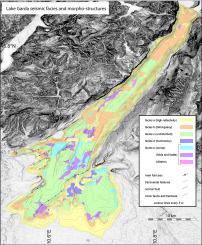当前位置:
X-MOL 学术
›
Geomorphology
›
论文详情
Our official English website, www.x-mol.net, welcomes your
feedback! (Note: you will need to create a separate account there.)
Morphotectonics and late Quaternary seismic stratigraphy of Lake Garda (Northern Italy)
Geomorphology ( IF 3.1 ) Pub Date : 2020-12-01 , DOI: 10.1016/j.geomorph.2020.107427 Luca Gasperini , Alfredo Marzocchi , Stefano Mazza , Roberto Miele , Matteo Meli , Hassan Najjar , Alessandro M. Michetti , Alina Polonia
Geomorphology ( IF 3.1 ) Pub Date : 2020-12-01 , DOI: 10.1016/j.geomorph.2020.107427 Luca Gasperini , Alfredo Marzocchi , Stefano Mazza , Roberto Miele , Matteo Meli , Hassan Najjar , Alessandro M. Michetti , Alina Polonia

|
Abstract Lake Garda, the largest lake in Italy at the southern front of the central Alps, provides a unique opportunity to reconstruct Quaternary geological processes related to the interplay between deglaciation driven sedimentation and tectonic activity. In fact, the topographic depression presently occupied by the lake was site of a major glacial tongue during the LGM, and is located close to the epicentral areas of two of the largest magnitude historical earthquakes recorded in the Po Plain, the Verona (Jan. 13, 1117) and Brescia, (Dec. 25, 1222) seismic events, characterized by Io IX-X MCS, respectively. Despite this peculiarity, geophysical surveys of the lake are scant. We present results of a waterborne geophysical survey of Lake Garda, leading to the acquisition of a densely-spaced grid of high-resolution seismic reflection profiles which image the lake floor and uppermost sedimentary sequence. These data enabled us to compile thematic maps which provide insights on active geologic processes in different sectors of the basin. We focused our work on a prominent seismic reflector (H1), correlated over the entire lake surface, to estimate the sediment deposition rate at the scale of the last 10 ka, and to evaluate the variability of seismic facies and geological processes in different sectors of the basin. Based on available stratigraphic data, we discuss whether H1 could mark the diachronic glacial/fluvio-glacial transition after the Last Glacial Maximum, when the ice tongues south of the Alps started to melt and collapse. We observed that sediments of the southern Lake Garda are affected by incipient tectonic deformation, and two major seismoturbidite-homogenite beds might represent over 50% of the Holocene sedimentary record in the lake depocenter, making the study of the Lake Garda stratigraphy an interesting tool for assessing earthquake hazards at the southern front of the Alpine chain.
中文翻译:

加尔达湖(意大利北部)的形态构造和晚第四纪地震地层学
摘要 加尔达湖是意大利中部阿尔卑斯山南部前缘最大的湖泊,为重建与冰川作用驱动的沉积作用和构造活动之间相互作用相关的第四纪地质过程提供了独特的机会。事实上,该湖目前占据的地形洼地是 LGM 期间主要冰川舌的所在地,靠近维罗纳波平原记录的两次最大级历史地震的震中区(1 月 13 日) , 1117) 和布雷西亚 (1222 年 12 月 25 日) 地震事件,分别以 Io IX-X MCS 为特征。尽管有这种特殊性,但对该湖的地球物理调查却很少。我们展示了加尔达湖水上地球物理调查的结果,导致获得高分辨率地震反射剖面的密集网格,这些剖面对湖底和最上层的沉积层序进行成像。这些数据使我们能够编制专题图,提供有关盆地不同部门活动地质过程的见解。我们将工作重点放在与整个湖面相关的突出地震反射器 (H1) 上,以估计过去 10 ka 尺度的沉积物沉积速率,并评估不同部门的地震相和地质过程的可变性。盆地。根据现有的地层数据,我们讨论了 H1 是否可以标志着末次盛冰期之后的历时冰期/水冰期过渡,当时阿尔卑斯山以南的冰舌开始融化和坍塌。
更新日期:2020-12-01
中文翻译:

加尔达湖(意大利北部)的形态构造和晚第四纪地震地层学
摘要 加尔达湖是意大利中部阿尔卑斯山南部前缘最大的湖泊,为重建与冰川作用驱动的沉积作用和构造活动之间相互作用相关的第四纪地质过程提供了独特的机会。事实上,该湖目前占据的地形洼地是 LGM 期间主要冰川舌的所在地,靠近维罗纳波平原记录的两次最大级历史地震的震中区(1 月 13 日) , 1117) 和布雷西亚 (1222 年 12 月 25 日) 地震事件,分别以 Io IX-X MCS 为特征。尽管有这种特殊性,但对该湖的地球物理调查却很少。我们展示了加尔达湖水上地球物理调查的结果,导致获得高分辨率地震反射剖面的密集网格,这些剖面对湖底和最上层的沉积层序进行成像。这些数据使我们能够编制专题图,提供有关盆地不同部门活动地质过程的见解。我们将工作重点放在与整个湖面相关的突出地震反射器 (H1) 上,以估计过去 10 ka 尺度的沉积物沉积速率,并评估不同部门的地震相和地质过程的可变性。盆地。根据现有的地层数据,我们讨论了 H1 是否可以标志着末次盛冰期之后的历时冰期/水冰期过渡,当时阿尔卑斯山以南的冰舌开始融化和坍塌。











































 京公网安备 11010802027423号
京公网安备 11010802027423号